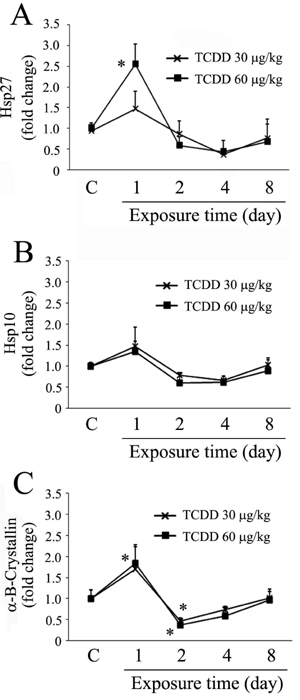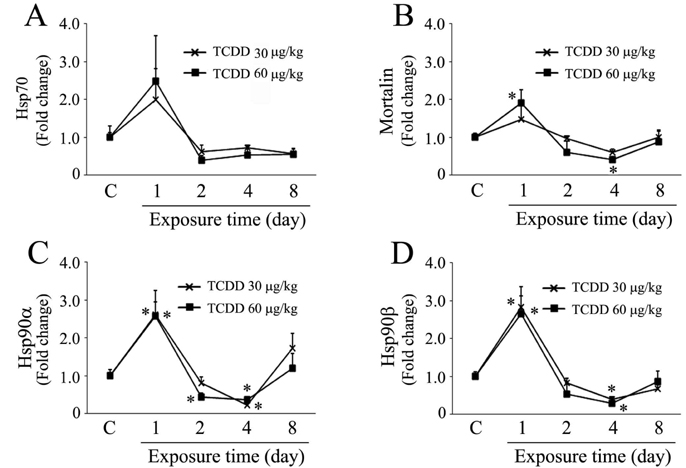Korean J Physiol Pharmacol.
2012 Dec;16(6):469-476. 10.4196/kjpp.2012.16.6.469.
Induction of Heat Shock Proteins and Antioxidant Enzymes in 2,3,7,8-TCDD-Induced Hepatotoxicity in Rats
- Affiliations
-
- 1Department of Biomedical Science, College of Health Science, Korea University, Seoul 136-703, Korea. woonun@korea.ac.kr
- 2Laboratory of Pharmacognosy, College of Pharmacy, Dankook University, Cheonan 330-714, Korea.
- 3Department of Life Sciences, College of Advanced Science, Dankook University, Cheonan 330-714, Korea.
- 4Research Institute of Heath Science, College of Health Science, Korea University, Seoul 136-703, Korea. seunggwan@korea.ac.kr
- KMID: 2285457
- DOI: http://doi.org/10.4196/kjpp.2012.16.6.469
Abstract
- 2,3,7,8-Tetrachlorodibenzo-p-dioxin (2,3,7,8-TCDD) is an environmental toxicant with a polyhalogenated aromatic hydrocarbon structure and is one of the most toxic man-made chemicals. Exposure to 2,3,7,8-TCDD induces reproductive toxicity, immunotoxicity, and hepatotoxicity. In this study, we evaluated how 2,3,7,8-TCDD-induced hepatotoxicity affect the expression of heat shock proteins and antioxidant enzymes using the real-time polymerase chain reaction (PCR) in rat. 2,3,7,8-TCDD increased heat shock protein (Hsp27, alpha-B-crystallin, Mortalin, Hsp105, and Hsp90s) and antioxidant enzymes (SOD-3, GST and catalase) expression after a 1 day exposure in livers of rats, whereas heat shock protein (alpha-B-crystallin, Hsp90, and GRP78) and antioxidant enzymes (SOD-1, SOD-3, catalase, GST, and GPXs) expression decreased on day 2 and then slowly recovered back to control levels on day 8. These results suggest that heat shock proteins and antioxidant enzymes were induced as protective mechanisms against 2,3,7,8-TCDD induced hepatotoxicity, and that prolonged exposure depressed their levels, which recovered to control levels due to reduced 2,3,7,8-TCDD induced hepatotoxicity.
Keyword
MeSH Terms
Figure
Reference
-
1. Pelclová D, Urban P, Preiss J, Lukás E, Fenclová Z, Navrátil T, Dubská Z, Senholdová Z. Adverse health effects in humans exposed to 2,3,7,8-tetrachlorodibenzo-p-dioxin (TCDD). Rev Environ Health. 2006. 21:119–138.2. Gray LE, Ostby JS, Kelce WR. A dose-response analysis of the reproductive effects of a single gestational dose of 2,3,7,8-tetrachlorodibenzo-p-dioxin in male Long Evans Hooded rat offspring. Toxicol Appl Pharmacol. 1997. 146:11. 20.3. Latchoumycandane C, Chitra C, Mathur P. Induction of oxidative stress in rat epididymal sperm after exposure to 2,3,7,8-tetrachlorodibenzo-p-dioxin. Arch Toxicol. 2002. 76:113–118.4. Kerkvliet NI. Immunological effects of chlorinated dibenzo-p-dioxins. Environ Health Perspect. 1995. 103:Suppl 9. 47–53.5. Schwarz M, Buchmann A, Stinchcombe S, Kalkuhl A, Bock K. Ah receptor ligands and tumor promotion: survival of neoplastic cells. Toxicol Lett. 2000. 112-113:69–77.6. Chang H, Wang YJ, Chang LW, Lin P. A histochemical and pathological study on the interrelationship between TCDD-induced AhR expression, AhR activation, and hepatotoxicity in mice. J Toxicol Environ Health A. 2005. 68:1567–1579.7. Slezak BP, Hatch GE, DeVito MJ, Diliberto JJ, Slade R, Crissman K, Hassoun E, Birnbaum LS. Oxidative stress in female B6C3F1 mice following acute and subchronic exposure to 2,3,7,8-tetrachlorodibenzo-p-dioxin (TCDD). Toxicol Sci. 2000. 54:390–398.8. Hassoun EA, Vodhanel J, Abushaban A. The modulatory effects of ellagic acid and vitamin E succinate on TCDD-induced oxidative stress in different brain regions of rats after subchronic exposure. J Biochem Mol Toxicol. 2004. 18:196–203.9. Fernandez-Salguero PM, Hilbert DM, Rudikoff S, Ward JM, Gonzalez FJ. Aryl-hydrocarbon receptor-deficient mice are resistant to 2,3,7,8-tetrachlorodibenzo-p-dioxin-induced toxicity. Toxicol Appl Pharmacol. 1996. 140:173–179.10. Nebert DW, Roe AL, Dieter MZ, Solis WA, Yang Y, Dalton TP. Role of the aromatic hydrocarbon receptor and [Ah] gene battery in the oxidative stress response, cell cycle control, and apoptosis. Biochem Pharmacol. 2000. 59:65–85.11. Benjamin IJ, McMillan DR. Stress (heat shock) proteins: molecular chaperones in cardiovascular biology and disease. Circ Res. 1998. 83:117–132.12. Hightower LE. Heat shock, stress proteins, chaperones, and proteotoxicity. Cell. 1991. 66:191–197.13. Ishida T, Oshimo T, Nishimura A, Mutoh J, Ishii Y, Koga N, Yamada H, Hashiguchi I, Akamine A, Oguri K. Reduction of the toxicity of 2,3,7,8-tetrachlorodibenzo-p-dioxin in mice using an antiulcer drug, geranylgeranylacetone. Biol Pharm Bull. 2004. 27:1397–1402.14. Liu S, Piatigorsky J. Regulation of mouse small heat shock protein αb-crystallin gene by aryl hydrocarbon receptor. PLoS One. 2011. 6:e17904.15. Sies H, Stahl W, Sevanian A. Nutritional, dietary and postprandial oxidative stress. J Nutr. 2005. 135:969–972.16. Basaga HS. Biochemical aspects of free radicals. Biochem Cell Biol. 1990. 68:989–998.17. Valko M, Leibfritz D, Moncol J, Cronin MT, Mazur M, Telser J. Free radicals and antioxidants in normal physiological functions and human disease. Int J Biochem Cell Biol. 2007. 39:44–84.18. Lee SH, Lee DY, Son WK, Joo WA, Kim CW. Proteomic characterization of rat liver exposed to 2,3,7,8-tetrachlorobenzo-p-dioxin. J Proteome Res. 2005. 4:335–343.19. Niittynen M, Simanainen U, Syrjälä P, Pohjanvirta R, Viluksela M, Tuomisto J, Tuomisto JT. Differences in acute toxicity syndromes of 2,3,7,8-tetrachlorodibenzo-p-dioxin and 1,2,3,4,7,8-hexachlorodibenzo-p-dioxin in rats. Toxicology. 2007. 235:39–51.20. Easton A, Guven K, de Pomerai DI. Toxicity of the dithiocarbamate fungicide mancozeb to the nontarget soil nematode, Caenorhabditis elegans. J Biochem Mol Toxicol. 2001. 15:15–25.21. Gupta SC, Siddique HR, Mathur N, Vishwakarma AL, Mishra RK, Saxena DK, Chowdhuri DK. Induction of hsp70, alterations in oxidative stress markers and apoptosis against dichlorvos exposure in transgenic Drosophila melanogaster: modulation by reactive oxygen species. Biochim Biophys Acta. 2007. 1770:1382–1394.22. Chuma M, Sakamoto M, Yamazaki K, Ohta T, Ohki M, Asaka M, Hirohashi S. Expression profiling in multistage hepatocarcinogenesis: identification of HSP70 as a molecular marker of early hepatocellular carcinoma. Hepatology. 2003. 37:198–207.23. Takashima M, Kuramitsu Y, Yokoyama Y, Iizuka N, Toda T, Sakaida I, Okita K, Oka M, Nakamura K. Proteomic profiling of heat shock protein 70 family members as biomarkers for hepatitis C virus-related hepatocellular carcinoma. Proteomics. 2003. 3:2487–2493.24. Singh MP, Reddy MM, Mathur N, Saxena DK, Chowdhuri DK. Induction of hsp70, hsp60, hsp83 and hsp26 and oxidative stress markers in benzene, toluene and xylene exposed Drosophila melanogaster: role of ROS generation. Toxicol Appl Pharmacol. 2009. 235:226–243.25. Papaconstantinou AD, Brown KM, Noren BT, McAlister T, Fisher BR, Goering PL. Mercury, cadmium, and arsenite enhance heat shock protein synthesis in chick embryos prior toembryotoxicity. Birth Defects Res B Dev Reprod Toxicol. 2003. 68:456–464.26. Oberemm A, Meckert C, Brandenburger L, Herzig A, Lindner Y, Kalenberg K, Krause E, Ittrich C, Kopp-Schneider A, Stahlmann R, Richter-Reichhelm HB, Gundert-Remy U. Differential signatures of protein expression in marmoset liver and thymus induced by single-dose TCDD treatment. Toxicology. 2005. 206:33–48.27. Hunter ES 3rd, Dix DJ. Heat shock proteins Hsp70-1 and Hsp70-3 Are necessary and sufficient to prevent arsenite-induced dysmorphology in mouse embryos. Mol Reprod Dev. 2001. 59:285–293.28. Beere HM, Green DR. Stress management - heat shock protein-70 and the regulation of apoptosis. Trends Cell Biol. 2001. 11:6–10.29. Mandal PK. Dioxin: a review of its environmental effects and its aryl hydrocarbon receptor biology. J Comp Physiol B. 2005. 175:221–230.30. Geist J, Werner I, Eder KJ, Leutenegger CM. Comparisons of tissue-specific transcription of stress response genes with whole animal endpoints of adverse effect in striped bass (Morone saxatilis) following treatment with copper and esfenvalerate. Aquat Toxicol. 2007. 85:28–39.31. Croute F, Poinsot J, Gaubin Y, Beau B, Simon V, Murat JC, Soleilhavoup JP. Volatile organic compounds cytotoxicity and expression of HSP72, HSP90 and GRP78 stress proteins in cultured human cells. Biochim Biophys Acta. 2002. 1591:147–155.32. Wu W, Welsh MJ. Expression of the 25-kDa heat-shock protein (HSP27) correlates with resistance to the toxicity of cadmium chloride, mercuric chloride, cis-platinum (II)-diammine dichloride, or sodium arsenite in mouse embryonic stem cells transfected with sense or antisense HSP27 cDNA. Toxicol Appl Pharmacol. 1996. 141:330–339.33. Hassoun EA, Stohs SJ. TCDD, endrin and lindaneinduced oxidative stress in fetal and placental tissues of C57BL/6J and DBA/2J mice. Comp Biochem Physiol C Pharmacol Toxicol Endocrinol. 1996. 115:11–18.34. Hassoun EA, Walter AC, Alsharif NZ, Stohs SJ. Modulation of TCDD-induced fetotoxicity and oxidative stress in embryonic and placental tissues of C57BL/6J mice by vitamin E succinate and ellagic acid. Toxicology. 1997. 124:27–37.35. Knerr S, Schaefer J, Both S, Mally A, Dekant W, Schrenk D. 2,3,7,8-Tetrachlorodibenzo-p-dioxin induced cytochrome P450s alter the formation of reactive oxygen species in liver cells. Mol Nutr Food Res. 2006. 50:378–384.36. Stohs SJ, Shara MA, Alsharif NZ, Wahba ZZ, al-Bayati ZA. 2,3,7,8-Tetrachlorodibenzo-p-dioxin-induced oxidative stress in female rats. Toxicol Appl Pharmacol. 1990. 106:126–135.37. Jin MH, Hong CH, Lee HY, Kang HJ, Han SW. Toxic effects of lactational exposure to 2,3,7,8-tetrachlorodibenzo-p-dioxin (TCDD) on development of male reproductive system: involvement of antioxidants, oxidants, and p53 protein. Environ Toxicol. 2010. 25:1–8.38. Senft AP, Dalton TP, Nebert DW, Genter MB, Hutchinson RJ, Shertzer HG. Dioxin increases reactive oxygen production in mouse liver mitochondria. Toxicol Appl Pharmacol. 2002. 178:15–21.39. Hassoun EA, Al-Ghafri M, Abushaban A. The role of antioxidant enzymes in TCDD-induced oxidative stress in various brain regions of rats after subchronic exposure. Free Radic Biol Med. 2003. 35:1028–1036.40. Kern PA, Fishman RB, Song W, Brown AD, Fonseca V. The effect of 2,3,7,8-tetrachlorodibenzo-p-dioxin (TCDD) on oxidative enzymes in adipocytes and liver. Toxicology. 2002. 171:117–125.41. Aly HA, Khafagy RM. 2,3,7,8-tetrachlorodibenzo-p-dioxin (TCDD)-induced cytotoxicity accompanied by oxidative stress in rat Sertoli cells: Possible role of mitochondrial fractions of Sertoli cells. Toxicol Appl Pharmacol. 2011. 252:273–280.42. Madamanchi NR, Li S, Patterson C, Runge MS. Reactive oxygen species regulate heat-shock protein 70 via the JAK/STAT pathway. Arterioscler Thromb Vasc Biol. 2001. 21:321–326.43. Lee YJ, Cho HN, Jeoung DI, Soh JW, Cho CK, Bae S, Chung HY, Lee SJ, Lee YS. HSP25 overexpression attenuates oxidative stress-induced apoptosis: roles of ERK1/2 signaling and manganese superoxide dismutase. Free Radic Biol Med. 2004. 36:429–444.44. Meng JL, Mei WY, Dong YF, Wang JH, Zhao CM, Lan AP, Yang CT, Chen PX, Feng JQ, Hu CH. Heat shock protein 90 mediates cytoprotection by H2S against chemical hypoxia-induced injury in PC12 cells. Clin Exp Pharmacol Physiol. 2011. 38:42–49.45. Lee J, Lim KT. Inhibitory effect of SJSZ glycoprotein (38on expression of heat shock protein 27 and 70 in chromium (VI)-treated hepatocytes. Mol Cell Biochem. 2012. 359:45–57.46. Forti E, Salovaara S, Cetin Y, Bulgheroni A, Tessadri R, Jennings P, Pfaller W, Prieto P. In vitro evaluation of the toxicity induced by nickel soluble and particulate forms in human airway epithelial cells. Toxicol In Vitro. 2011. 25:454–461.47. Jones G, Butler WH. A morphological study of the liver lesion induced by 2,3,7,8-tetrachlorodibenzo-p-dioxin in rats. J Pathol. 1974. 112:93–97.48. Gupta BN, Vos JG, Moore JA, Zinkl JG, Bullock BC. Pathologic effects of 2,3,7,8-tetrachlorodibenzo-p-dioxin in laboratory animals. Environ Health Perspect. 1973. 5:125–140.49. Pohjanvirta R, Kulju T, Morselt AF, Tuominen R, Juvonen R, Rozman K, Männistö P, Collan Y, Sainio EL, Tuomisto J. Target tissue morphology and serum biochemistry following 2,3,7,8-tetrachlorodibenzo-p-dioxin (TCDD) exposure in a TCDD-susceptible and a TCDD-resistant rat strain. Fundam Appl Toxicol. 1989. 12:698–712.
- Full Text Links
- Actions
-
Cited
- CITED
-
- Close
- Share
- Similar articles
-
- Expression of Heat Shock Protein 70 m-RNA in Rat Bladder Overdistended by Diuresis
- Heat Shock Protein Induction By An Infrared Warm Compression Device
- Expression of Heat Shock Protein 70 m-RNA in Non-obstructed Bladder Tissue in Rats with Diuresis
- Effect of Heat Shock on the Vascular Reactivity and Expression of Heat Shock Protein in an Animal Model of Type 2 Diabetes Mellitus (OLETF rat)
- The Role of Heat Shock Protein in Perinatal Fields






